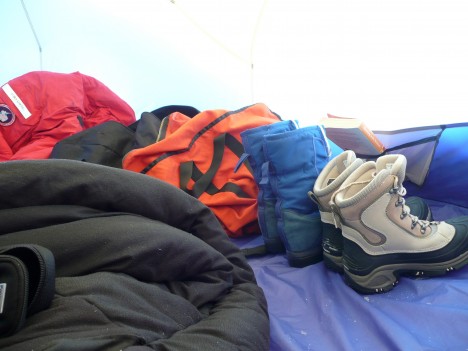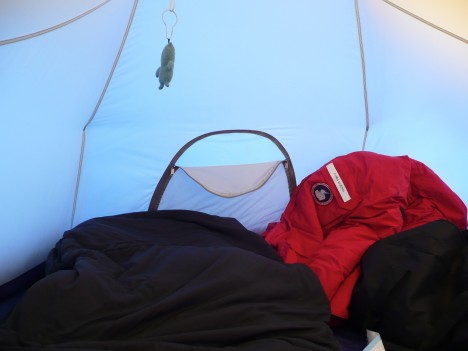

By Bob Bindschadler
McMurdo (Antarctica), 14 December — (Warning: this entry is not for the weak of heart.) Woe is me. A logistics scourge seems to have befallen our project. The past two days have been filled with nothing but bad news. The traverse from Byrd to PIG not only has continued to encounter soft snow, but the transmission on one tractor has failed, and a hydraulic line on another one has a leak that has stopped it literally in its tracks. Much of the cargo being hauled by the tractors is loaded on sheets of very slippery, but strong, plastic. Well, maybe not so strong, after all: This is the second season these sheets have been used and they are starting to crack and break, forcing the traverse party to stop, jigger the load around and then start up again. All this leaves me with the mental image of bits of the traverse littering the trail from Byrd to PIG. Still, the traverse people press onward, with fewer vehicles and less cargo. Their estimate is to arrive at PIG on Friday, but unless they cover more than the 20 miles they’ve completed each of the past two days, it will take yet longer.
The flying side is not going much better. Bad weather continues to plague both of the possible refueling stops so the put-in flight has been cancelled every morning. The weather is forecast to improve at those sites, both of them in the interior of West Antarctica, but (you guessed it) weather at PIG is deteriorating now. We in the field party marooned in McMurdo test our mental mettle by checking a couple of web sites that allow us to view the weather forecasts for the key stations involved in this effort, as well as David Holland’s web cam, which remains our lone virtual presence at PIG. It hurts to see sunny skies there and not be able to fly a plane there.
If this was a football game, the cargo managers would receive a penalty for “piling on”. Yesterday we had a meeting where we heard that our cargo was not the 9,000 pounds that we had planned, but rather 15,000 pounds, necessitating an additional flight to PIG (#9, if you are keeping count). We were only slightly surprised, because I saw this coming. In fact, I was the one who asked for the meeting so we could address any problem early. As I explained in my previous post, we’ve had to add a number of items to our cargo line due to less being taken by the traverse. Also, our colleague Sridhar Anandakrishnan was sent to his early season work site without the skidoos he was supposed to use there, so we have to bring them to PIG via another route. I felt it was time to push back on the size and design of the PIG Main Camp. I said we would lower the priority of some limited parts of our project, so they could arrive on this later flight, but I couldn’t shed all of the 6,000-pound extra cargo. I insisted on some sacrifices from the Main Camp. The head of construction there offered to consider downsizing some of the plumbing (!) and electrical components of the camp. Most others didn’t offer much. If the Herc pilots like the runway when they get to PIG, they might increase the allowed cargo limit (ACL) of subsequent flights, so this problem might go away, but this strikes me as wishful thinking. Nevertheless, I’ll be meeting with the head of the LC-130 squadron to discuss the benefits of even a 500-pound increase of the ACL. Exploring every possible way of getting us to PIG sooner is what my job here has become.
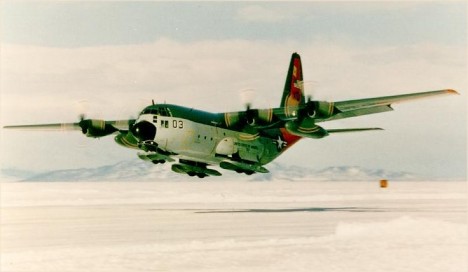
In that vein, I’ve come up with yet another strategy to recover some lost time. It involves having a Twin Otter airplane attempt a landing at our intended drill camp location on the ice shelf. This is a bit of déjà vu because three years ago I landed on the ice shelf in a Twin Otter only to be told the surface was too hard and rough for repeated landings. Some super high-resolution satellite imagery suggests to us the result might be different at this new site, so I want to try it again.

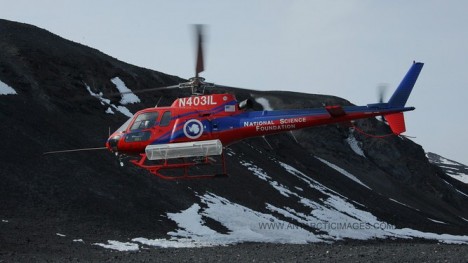
I’ve had to write to my program manager back in DC to ask that he supports this request. I made the case that, if successful, we could get the drill camp up and running before helos arrive and are operational at PIG Main Camp. We still have work to do that only the helicopters can support, but we are feeling the increased time pressure of time and splitting the support load would definitely help. It could also eliminate the need for any helicopters next season if we can complete the helo-only work this year and the drilling can be supported by Twin Otters. I delivered my sales pitch to the Twin Otter pilots after lunch today, and I’ll hear from NSF back in DC tomorrow.
On the bright side, I have plenty to restore a balanced perspective. Today is the 100th anniversary of Roald Amundsen’s arrival at the South Pole. As everyone surely knows, Robert Falcon Scott and his field party reached the same spot a month later, but perished on the return journey. I am not about to set out to ski/man haul our cargo to PIG, nor I expect to suffer the extraordinary hardships of either Scott or Amundsen. Antarctic science nowadays is usually hard, often frustrating, but it is rarely life threatening. I’ll take that as some much needed good news.
By Bob Bindschadler
McMurdo (Antarctica), 12 December — Well, nearly a week has whizzed by. We have been quite busy, but it doesn’t feel like there’s been much real progress. Every day seems to come with its own set of new problems and developments. This includes cargo hunting (yes, it was still going on until recently—but it’s DONE now), remembering some item or tool that would probably prove useful (then finding it and getting it) or thinking of some small thing to build and then getting the carpenters or machinists to understand what we want, (then waiting for the item, packing it and getting it into the cargo system.)
Tying up these loose ends didn’t add much weight to our overall cargo load, but we knew we were going to be heavier than we had planned for because there were some heavy items that failed to make it on flights to Byrd Station, where the over snow traverse was going to be taking them to the main camp at Pine Island. These problems originated way back in early September: Early season weather in West Antarctica was worse than usual, which meant fewer flights to Byrd and less of our cargo getting there when the traverse needed to start. Without sufficient cargo, the traverse managers held their departure back a few days. When they tried to start, one of the large tractors failed, leaving them with only three. This actually worked out better, since there was less cargo to pull. Now we hear that the traverse is encountering soft snow, slowing its progress even more. The image below is a map of the traverse’s progress through last night. It’s averaging less than 4.5 miles per hour and under 60 miles per day: At this rate, it will be another five days before it arrives at PIG.
It’s a polar tortoise and hare race. The traverse is undoubtedly the tortoise, but the hare is having its own difficulties. Flights to PIG take “only” 5 hours (one-way) and were scheduled every day since Wednesday last week (except Sunday). Each one of them was cancelled because of bad weather at one or more of the required landing spots: McMurdo, Byrd or PIG. Good weather at Byrd is necessary to refuel the plane on its way home. Today’s weather looked the best of all days and, unlike last week’s flights, the plane actually took off from McMurdo. But two hours into the 5-hour flight, the weather went bad at Byrd. WAIS is another nearby station that could refuel the aircraft, but weather also went bad in there not long after. So the plane was ordered back to McMurdo before it was so far away and had so little fuel that it would get stuck somewhere out in the middle of West Antarctica.
It’s anybody’s guess who will get to PIG first: the traverse or the put-in flight. The traverse is more important, because it has the heavy equipment to dig out all the camp material left there at the end of last season (a small camp was set up then), groom the runway used last season (if the flags marking it can be found, that is) and tap into the all-important fuel bladder. Getting to that fuel is key because with it the LC-130 cargo planes (called “Hercules” or “Hercs”, for short) can get enough fuel to get back to McMurdo without having to stop at Byrd or WAIS. This will make missions to PIG less susceptible to weather cancellations.
Our cargo handling is done. But, as I mentioned, since now we have to fly some items that didn’t get to Byrd by the traverse’s departure, our stuff weighs more than planned. Whether that requires another flight will not be decided until we hear if the groomed runway at PIG can handle heavier landing weights. It’s all connected: cargo, tractors, fuel, airplanes and weather. Meanwhile, we will make our case for moving our necessary science cargo up in the queue, so we don’t suffer more delays.
It’s not all bad news. These past few days have contained some bright spots. Our project has received a lot of attention. A Blue Ribbon Panel, here last week to assess the effectiveness of the US Antarctic Program, really likes the social relevance of our mission and its interdisciplinary character. I gave a science lecture on PIG to a packed audience and got superb reviews. Many people here have touched the project in one way or another and I wanted them to understand what it was about and why we have to go to someplace that is so hard to get to. I also was singled out to prepare a poster and speak to the Prime Minister of Norway, who is flying to the South Pole to mark the 100th anniversary of Roald Amundsen’s trip.
Attention is great; more progress would be even better!
By Bob Bindschadler
McMurdo (Antarctica), 6 December — Stuff, stuff and more stuff. When you have to take everything with you to a remote place, you end up with a lot of stuff. When you add to that the equipment necessary to make the measurements we intend, the pile of stuff gets even bigger. That’s what we’ve been doing that past few days: piling up stuff.

I mentioned before that many items we sent down to Antarctica were found in various locations around town. Finding each item was followed by getting the right label for it (with a unique tracking number), so once the label was attached, it could be moved to a common location. That is where our pile of stuff is now. After talking to the right cargo people here, looking at their documents and comparing their lists with ours, we are pretty sure that the stuff we can’t find in McMurdo took an early 1,000-mile flight to Byrd Station, where a glorified polar tractor will drag it on a sled for the remaining 400 miles from Byrd Station to the PIG Main Camp. This is not an exciting trip; the traverse participants lumber along at about 5 miles an hour and it takes them 7 mind-numbing days to complete the trip. They then will leave their loads, turn around and repeat the journey back to Byrd. What is exciting about this traverse for us is that with yesterday’s successful flight to Byrd, the traverse party has enough material to get underway. So the project is finally taking the next step toward PIG—at 5 miles per hour!
Meanwhile, back in McMurdo, our task is to pull together the variety of other stuff we will need at our camp. Our cook, Jake, is handling all the cooking and eating stuff. We are checking tents, sleeping bags, radios, satellite phones, GPSs, shovels, ice screws, safety harnesses, ice axes, snowmobiles, generators, battery chargers, chainsaws,… The list is pretty long and detailed. McMurdo is well stocked with these types of items because many different field parties draw on this inventory. Those hearty souls that spend the entire winter at McMurdo do an excellent job of cleaning and repairing and preparing this equipment for summer field parties. We take our portion, pack it, weigh it, document it, label it and add it to our pile of stuff.
The next, and bigger step toward PIG may come tomorrow. The put-in flight is scheduled for a morning departure. It takes over 5 hours to fly there on a LC-130 (the “L” means it is a modified C-130 cargo plane—the modification is the inclusion of skis that straddle the regular wheels). The forecast is not good—40-knot winds now, increasing through the night. However, after that storm passes, the winds are expected to die down and we could have a day (or two? Please make it two!) of clear, calm weather there. Only five people are going to be getting off the plane if it makes it in. They will set up communications, erect a small communal tent and start the process of digging out the camp material left there at the end of last field season. It’s their stuff.
P.S. You can view the PIG Main Camp site through daily photos taken by two web cams we set up last year.
By Lora Koenig
Byrd Camp (Antarctica), December 7 — At 4:45 PM today we boarded another Delta for a ride to Pegasus field. The last weather report we had for Byrd Camp was for half-mile visibility and 40-knot winds with blowing snow. The conditions were predicted to continue to deteriorate, so I expected the flight to be canceled. When we arrived Pegasus we saw our gear being loaded on an LC-130 flown by the 109th Air Wing. We also saw a plane taxiing to the skiway that was headed to WAIS Divide camp, which is about 100 kilometers (62 miles) from Byrd. So when we say that plane take off, we knew we had a good chance of getting into Byrd.
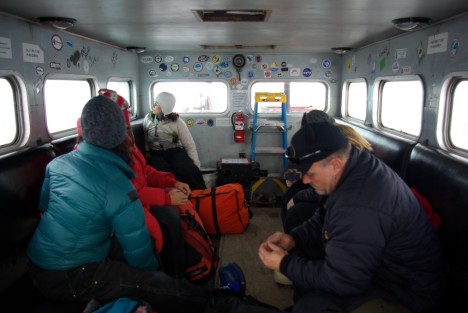
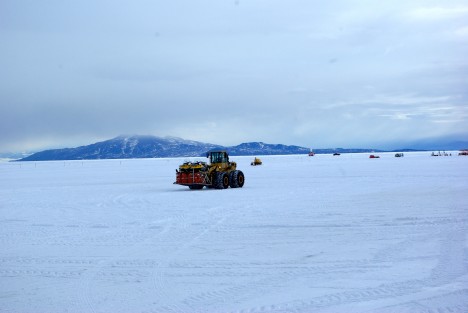
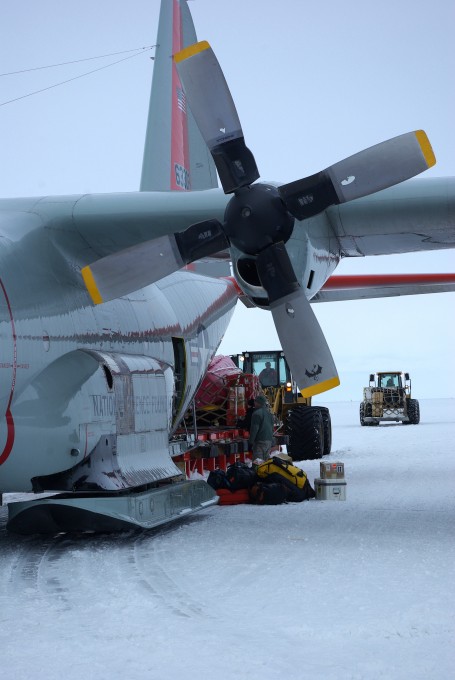
We took off at around 8 PM for the 3-hour flight to Byrd. Jessica got to ride in the cockpit for take-off. During the flight, we looked out the windows into clouds for most of the time, but at one point the Ross Ice Shelf was visible and we saw a large crack in the ice shelf, which was exciting to see though I do not know anything about the science behind it. I will ask and expert in a few weeks and get back to you with more information about the crack.
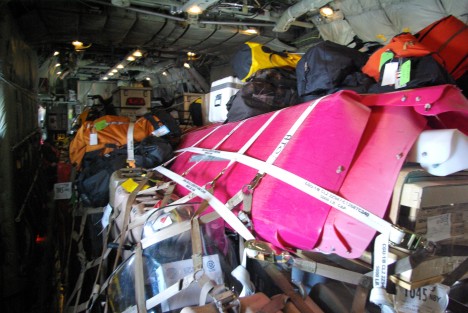
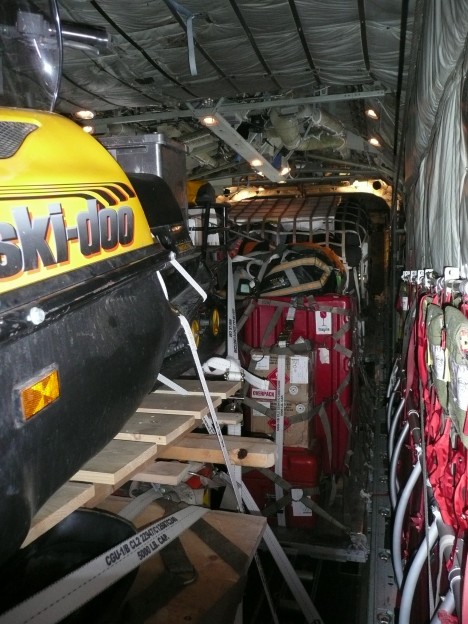
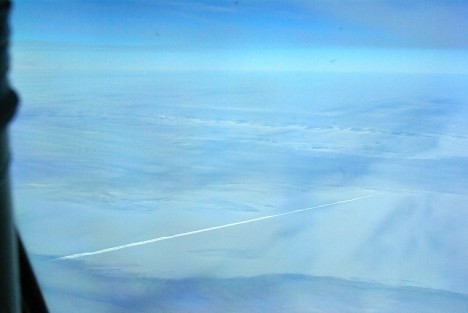

We arrived Byrd Camp around 11:00 PM. After we landed, all of our cargo was combat off-loaded. A combat off-load is when they open the back of the LC-130 and send the palettes out the back with a swift kick and a sudden acceleration of the plane. This method is very rough on our gear and we will have to double-check everything again to make sure nothing is broken. One of my constant reminders to the team is, “Don’t break anything”: We have to fix anything we break and we may not have the parts. So combat off-loading of gear makes me very nervous, but we didn’t have any other choice. And it is actually really fun to see the combat off-loads if you forget that it is your gear.
Here are some pictures of the combat off-load:
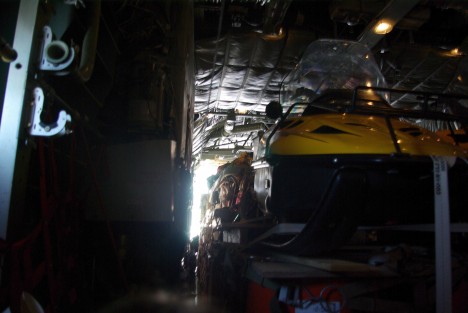
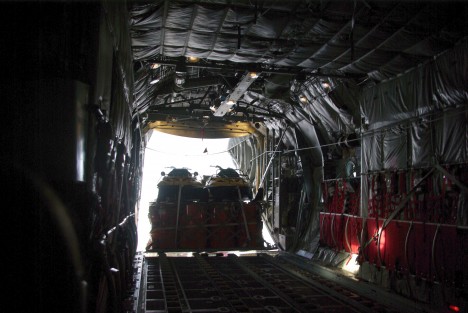
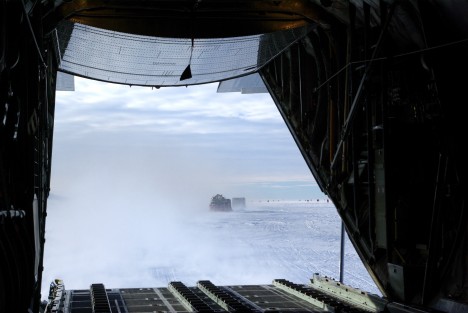
Here is a picture of the team finally in the field.
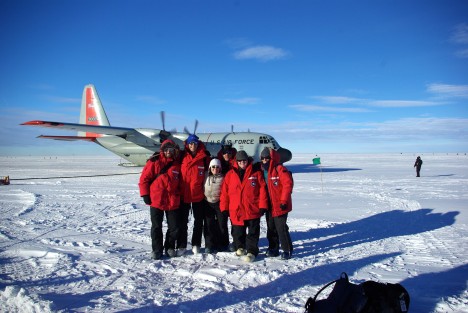
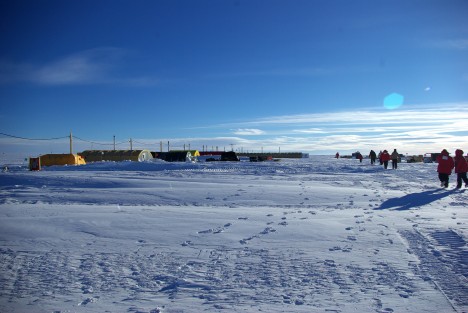
We had a quick tour of Byrd Camp and then went to tent city to our tents to sleep for the night. I was warm all night but others were a bit cold on their first night in their tents. We are finally ready to start the science!

